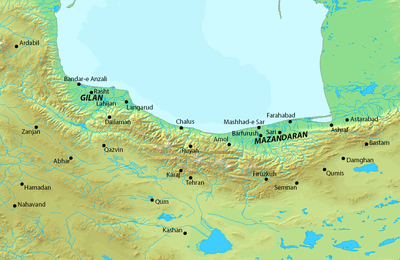Iskandar-i Shaykhi
Iskandar-i Shaykhi (Persian: اسکندر شیخی), was ruler of the Afrasiyab dynasty from 1393 to 1403. He was the son and successor of Kiya Afrasiyab.
Biography

In 1359, Mir-i Buzurg, a Sayyid from Dabudasht, defeated and killed Iskandar's father Afrasiyab together with his three sons. Mir-i Buzurg shortly conquered the territories of the Afrasiyab dynasty, and laid foundations to the Marashis. Afrasiyab had several other sons who tried to restore Afrasiyabid authority in Mazandaran. His son Fakhr al-Din Chulabi murdered one of the sons of Mir-i Buzurg, which resulted in a massacre of most of the Afrasiyabid family. Afrasiyab's other son Iskandar-i Shaykhi, managed to escape the massacre and flee to Herat, where he began serving the Kartids.
However, the Turco-Mongol warlord Timur, shortly made the Kartids his vassal state, and Iskandar shortly entered into his service. In 1393, Iskandar together with Timur, invaded Mazandaran, brutally sacking its two major cities Amol and Sari. Timur also repelled the Marashis from Mazandaran, and appointed Iskandar as the governor of the region. Iskandar then made Amol his capital and began taking revenge on the Marashis by destroying the tomb of Mir-i Buzurg in Sari.
Iskandar later aided Timur in his campaign to Iraq, Shirvan and Anatolia. After having achieved great success during the campaign, Iskandar was allowed to return to Mazandaran, but shortly rebelled against Timur. In 1403, Timur invaded Mazandaran to repress the rebellion. Iskandar, together with his wife and two children, then fled from Amol. Iskandar, fearing that they might betray him, killed them.
Iskandar was shortly killed by the army of Timur, who under the orders of Timur, had Iskandar's head sent to his son Kiya Husayn I, who had fortified himself in Firuzkuh. Kiya Husayn I, after having seen the head of his father, agreed to surrender to Timur, and was pardoned by the latter, who acknowledged him as the ruler of the Afrasiyab dynasty.
Sources
- Bosworth, C. E. (1984). "ĀL-E AFRĀSĪĀB". Archived copy. Encyclopaedia Iranica, Vol. I, Fasc. 7. London u.a.: Routledge & Kegan Paul. pp. 742–743. Archived from the original on 2014-02-20. Retrieved 2014-03-02.CS1 maint: ref=harv (link) CS1 maint: archived copy as title (link)
- Manz, Beatrice Forbes (1999). The Rise and Rule of Tamerlane. Cambridge: Cambridge University Press. pp. 1–231. ISBN 9780521633840.
iskandar-i shaykhi.
| Preceded by Rida al-Din (Marashis) |
Afrasiyabid ruler 1393–1403 |
Succeeded by Kiya Husayn I |